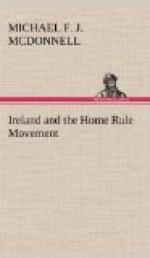The multiplication of schools arising partly from the denominationalism which so largely holds the field is accentuated by the financial system which is adopted by the National Board. In all the schools under its control, with the exception of the 300 convent and monastery schools, where the State-aid takes the form of a capitation grant, the grant is ear-marked for the payment of teachers’ salaries, the largest charge incurred by the school; and in this way the responsibility on that account and the occasion for economy on that score of the managers is removed, leaving to them only the control of the school buildings. Moreover, the non-application of the capitation system of grants fails to bring into play what would be a direct financial inducement to the locality to improve the school attendance of the children, as would also any system of local control. The small size of existing school areas results in inevitable mischief, for under it the poorest districts are those in which the school accommodation is worst, and since more money has to be raised than in richer localities the poorer districts have to pay most and the richest least for elementary education.
A primary effect of the larger number of schools is that the average attendance is much smaller than in Scotland, where conditions are in many respects similar, and side by side with the small size of the schools goes the very low standard of salaries paid to the teachers, which begin at L56 a year for men and L44 each for women, and advance by triennial increments to L172 for men and L140 for women. Two-thirds of the primary school teachers of Ireland have a salary of less than 30s. a week. The average payment to head teachers is in Scotland 75 per cent. and in England 48 per cent. higher than in Ireland. The general state of inefficiency of education in Ireland may be gathered from the fact that the Census of 1901 showed that of persons over five years of age no less than 13.7 per cent. could neither read nor write, the percentage of illiteracy being in the four provinces, 11.3 in Leinster, 12.5 in Ulster, 14 in Munster, and 20.7 in Connaught. The children in Scottish schools attend on 85 per cent. of the days on which the schools are open, in English on 84 per cent., and in Irish schools only on 65 per cent.; but in considering these figures allowance must be made for the fact that school attendance in Great Britain has been compulsory for just over thirty years, while in Ireland it was only in 1892 that an Act was passed sanctioning the formation of School Attendance Committees with power to enforce the attendance of children at school.




